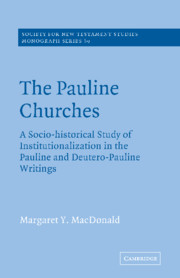 The Pauline Churches
The Pauline Churches Published online by Cambridge University Press: 10 December 2009
Having illustrated how sociological analysis might be employed to study development in Pauline communities, it is necessary to consider the potential hazards of such a methodology. The following investigation includes a discussion of where the social sciences stand in terms of an inter-disciplinary approach to New Testament studies and a response to the objections levelled against those employing social-scientific modes of interpretation.
Why employ social sciences?
The most powerful forerunner of present interests in socio-historical study of New Testament texts is found in one wing of the Chicago school where, between approximately 1894 and 1920, scholars exhibited a keen interest in the social history of early Christianity. This short-lived movement was characterized especially by the work of Shailer Mathews and Shirley Jackson Case. For the most part, the insights of the members of the Chicago school were buried for decades under the pursuits of New Testament criticism that gave only peripheral treatment to the ‘Sitz im Leben’, drew occasional parallels with contemporary literature, or issued a seldom heeded cry for more attention to ‘sociological realities’. One such appeal was made by Oscar Cullmann in 1925 with respect to form-critical studies. He stressed the need for a special branch of sociology devoted to the study of the laws which govern the growth of popular traditions.
To save this book to your Kindle, first ensure [email protected] is added to your Approved Personal Document E-mail List under your Personal Document Settings on the Manage Your Content and Devices page of your Amazon account. Then enter the ‘name’ part of your Kindle email address below. Find out more about saving to your Kindle.
Note you can select to save to either the @free.kindle.com or @kindle.com variations. ‘@free.kindle.com’ emails are free but can only be saved to your device when it is connected to wi-fi. ‘@kindle.com’ emails can be delivered even when you are not connected to wi-fi, but note that service fees apply.
Find out more about the Kindle Personal Document Service.
To save content items to your account, please confirm that you agree to abide by our usage policies. If this is the first time you use this feature, you will be asked to authorise Cambridge Core to connect with your account. Find out more about saving content to Dropbox.
To save content items to your account, please confirm that you agree to abide by our usage policies. If this is the first time you use this feature, you will be asked to authorise Cambridge Core to connect with your account. Find out more about saving content to Google Drive.